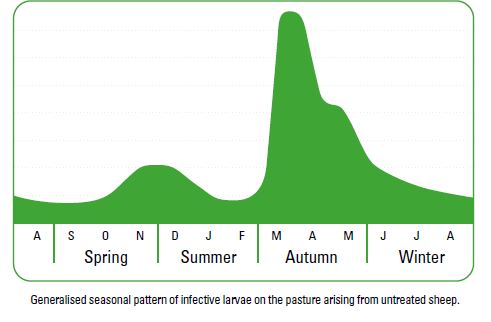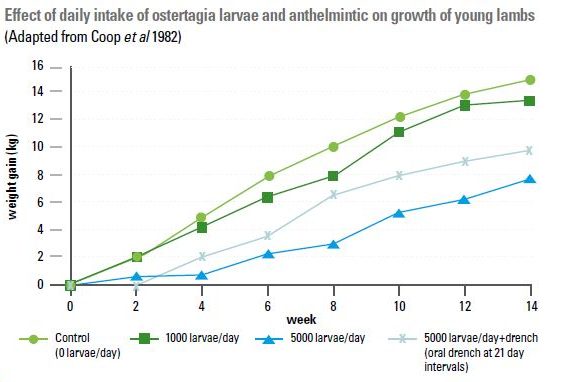

FAQ Drench
When to drench?
Larval numbers on pasture are generally highest in late spring and autumn. A minimum interval of 28 days between drenches is considered best practice.
On most farms, drenching sheep and calves with effective short-acting, oral, combination drenches every 28 days over their first summer and autumn, and then extending the drench interval out to 6-9 weekly until 15-18 months of age should minimize production losses due to parasites, without overusing drench.

Why drench?
The effect of worms on livestock will vary with the severity of infection as well as age and stress level of the animal. Effects may be clinical (visible disease-like symptoms e.g., diarrhoea) or subclinical (losses in animal productivity e.g., weight gain).

Intensive grazing exposes animals to a higher level of larval intake compared to animals lightly grazing the same pasture, because most larvae are found in the first 2cm of pasture height or in the first 1cm of soil.
Responsible use of effective drenches is critical for the long-term profitability of your farm. Drench resistant parasites are becoming more common, so balancing production gains with long-term drench efficacy is the goal of a sustainable parasite management plan. The Coopers range of drenches are all short-acting, oral drenches containing multiple actives. These qualities align with industry best-practice drenching recommendations for sheep and cattle.
When used in appropriate classes of stock at strategic times of year, Coopers drenches can form the backbone of your parasite management plan, helping delay drench resistance while minimizing the impact of parasites on productivity. Coopers is a brand that has stood the test of time and we want our drenches to do the same.
Who to drench?
Healthy cattle and sheep develop their own immunity to parasites with exposure over time. But while they develop immunity, they can suffer production losses, ill health or even death. Undrenched animals with low immunity to parasites contribute significant numbers of worm larvae onto paddocks, increasing the challenge to the rest of the herd/flock. Drenching young animals at regular intervals while they mature and develop immunity helps to address this. Most healthy adult cattle and sheep don’t routinely need to be drenched. Some exceptions may exist (e.g., if Barbers pole worm, a blood sucking worm, is common in your area), so check with your animal health professional if you’re not sure.
Best drench for cattle?
Provided cattle weigh over 100 kg LW, Alliance and Converge may be used. These are low dose, short-acting, triple-active and dual-active combination oral drenches respectively. Both are very effective against Ostertagia (Teladorsagia), including inhibiting larvae, and Cooperia species; as well as Dictyocaulus viviparus (lungworm). Scanda may be used in lighter weaned cattle weighing between 50 and 100 kg LW.
Best drench for sheep?
Provided lambs weigh over 20 kg LW, Alliance and Converge may be used. These are low-dose, short-acting, triple-active and dual-active combination oral drenches respectively. Both are effective against Teladorsagia (Ostertagia circumcincta), Haemonchus contortus (Barbers Pole worm), Trichostrongylus and Nematodirus. Scanda may be used in lighter lambs weighing between 15 and 20 kg LW.
Why combination drenches?
Using multiple actives from different drench families at the same time is a proven strategy to help delay parasites from developing drench resistance. Combination drenches should be used before drench resistance to any individual active in the drench is detected on the farm.
Why use short acting drenches?
Using short-acting drenches means that the worms are exposed to drench long enough to be lethal to them but not so long that it gives worms time to develop resistance against them. Consistent use of longer-acting drenches has been shown to increase the risk of developing resistance against them because as the effect of the drench wears off, worms can be exposed to levels that are not necessarily lethal; allowing them to survive and reproduce. There is little need to use longer-acting drenches if animals are being moved to paddocks that have lower larval challenge.
Why oral drenches?
Studies show the benefits of oral drenching over injectable or pour-on administration. The studies showed oral treatments were significantly less variable in efficacy and that oral administration resulted in higher concentration of the active reaching the target worms in the gastrointestinal tract. For this reason it is recommended to use an oral drench for as long as possible (e.g. while it can be administered safely).

Study showing effect of formulation on drug delivery and efficacy.
D.M. Leathwick, C.M. Miller. Veterinary Parasitology 191 (2013)

